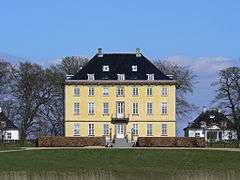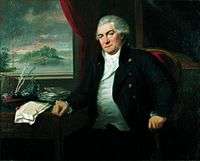Dronninggård
| Dronninggård | |
|---|---|
 Næsseslottet House seen from the south | |
| General information | |
| Architectural style | Neoclassical |
| Location | Rudersdal, Copenhagen, Denmark |
| Country | Denmark |
| Coordinates | 55°48′24″N 12°26′04″E / 55.8065671153°N 12.4343867952°E |
| Completed | 1783 |
| Client | Frédéric de Coninck |
| Design and construction | |
| Architect | Andreas Kirkerup |
Næsseslottet, is an 18th-century country house located on the shores of Lake Furesøen at Lyngby north of Copenhagen, Denmark. The name, which translates as "Peninsula House", is a reference to the buildings setting on a narrow peninsula which extends from the east shore of the lake. The estate had previously been a royal farm known as Dronningegård and this name has long been associated with the locale.
History
Origins
Dronninggård was built in 1661 to manage the Crown's extensive holdings of farm land in the area. The farm belonged to the powerful Queen Sophie Amalie until her death in 1714, hence the name which translates as Queen's House. After that, the property was sold and changed hands several times but eventually it fell into a state of despair.[1]
Frédéric de Coninck's house

The main building stood as a ruin when the estate was acquired by Frédéric de Coninck in 1781??. Originally from the Netherlands, he had emigrated to Denmark in 1763 where he had set up a shipping company and made a fortune in foreign trade. He commissioned court architect Andreas Kirkerup to build a new house while the old building was rebuilt and converted into a farm.
.jpg)
Frédéric de Coninck was very fond of the estate and its surroundings. When he acquired the Danneskiold-Laurvig Mansion in Copenhagen (now known as Moltke's Mansion after a later owner) in 1788, to serve as his new residence during the winter season, he commissioned the painter Erik Pauelsen to create two large paintings and three overdoors with motifs of his Dronninggård estate.[2]
In 1802, Frédéric de Coninck built an additional house on the land, Frederikslund, (Frederik's Grove), for his son Fritz (Frédéric) de Coninck. It was designed by the French architect Joseph-Jacques Ramée who also designed many other country houses in the area around that time, including Sophienholm and Øregård.
Later history
After de Coninck's death at Næsseslottet in 1811 both the shipping empire and the Dronninggård estate was passed on to his son but the times were changing. Denmark was experiencing hard times after the state bankruptcy in 1813 and after de Coninck's company went bankrupt in 1821, Dronninggård had to be sold. The following owners generally preferred to reside at Frederikslund while Næsseslottet fell into neglect.[3] In 1898, it was acquired by a consortium and turned into a bathing hotel while most of the land was sold off in lots. However, the venue was no great success and in 1906 the property was sold to August Bagge, a book publisher.
Later in the century the estate was acquired by Copenhagen Municipality and turned into a medical facility. In 1984 the Danish Red Cross used the building as their first refugee centre in Denmark.
In 1986 it once again passed into private ownership and has now been turned into an office hotel.[4]
Architecture
Built in Andreas Kirkerup style, the house consists of three storeys under a hipped roof with black-glazed tiles. The main facade is seven bays long. Of the original 18th century interiors, only the dining room has been preserved.
Park and monuments

Frédéric de Coninck charged the Flemish landscape architect J.F.H. de Drevon with the design of the surrounding parklands. Drevon was inspired by the manor house gardens of southern England and created the first Romantic garden in Denmark.[5] It was planted with exotic trees many of which still grow there today. The pavilions in the park are not from the original English garden.
The park is also home to a number of monuments and decorative features. The sculptor Carl Frederik Stanley created several monument for the park, including one to trade and shipping. Johannes Wiedewelt has contributed with an obelisk and ornamental vases.
The two pavilions and the stables were designed by Axel Berg and are from about 1900.[6]
See also
References
- ↑ "Tidslinie" (in Danish). Næsslottet. Retrieved 2012-05-28.
- ↑ "The Dronninggård Chamber". Moltkes Palæ. Retrieved 2012-05-29.
- ↑ "Looking for a different adventure?" (in Danish). geocashing. Retrieved 2012-05-30.
- ↑ "Historie" (in Danish). Næsseslottet. Retrieved 2012-05-30.
- ↑ "Næsseslottet" (in Danish). Rudersdal Kommune. Retrieved 2012-05-29.
- ↑ "Sag: Næsseslottet, Dronninggård". Kulturstyrelsen. Retrieved 2012-05-29.
External links
| Wikimedia Commons has media related to Næsseslottet. |
- Official website (in Danish)